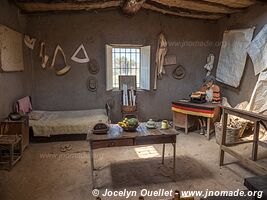Nazca and Palpa Lines
Maria Reiche, archeologist and mathematician
This small museum is dedicated to Maria Reiche, an archeologist and mathematician who devoted a large part of her life to the study and conservation of the Nazca Lines. She was born in 1903 and died in 1998 at the age of 95.
If you don't know about the Nazca Lines, imagine a figure etched on the soil of the Nazca desert, but with massive proportions. For example, the figures’ named 'Alcatrax' measures 280 metres in length (an American football field measures 109 metres on its longest side). These figures are often etched on a completely flat area or on a small hill with a soft incline.
Maria Reiche studied the Nazca Lines from 1940 on. It is important to understand the difficulty to study a geometric form when you can see it in its entirety. It is really necessary to fly over it to understand the magnitude of these geoglyphs.
Ironically, with modern drones, it is easy to measure all the geoglyphs in a few days, something that required several years, or even several decades, for Maria Reiche.
Introduction to the Nazca Lines
The Nazca Lines refer to a series of geoglyphs and lines etched on the soil of the Nazca desert. Their creation date from 500 BC to AD 500. They were created by removing a layer of dirt from the ground. The soil on the surface is of a red-brown colour while the soil exposed after a small excavation is more yellow-gray.
There is a large number of straight lines , but also a good number of figures representing plants or animals. The geoglyphs measure between 400 metres and 1.1 kilometres. The length of all the lines combined is estimated to be 1300 km over an area of 50 km2. A typical line has a depth of 10 cm to 15 cm and a width that varies greatly; almost half of them have a width of 30 cm, but some reach up to 1.8 metres.
Some geoglyphs are visible from the ground or a hill, but for the most part, it is easier to observe them by flying over at a height of about 500 metres. It is surprising to know that most figures are drawn from one continuous line; as an analogy, we could say that the figure was drawn without lifting the pen even once. The widest animal figures reach length of 280 metres.
The Nazca Desert is an isolated place, very dry where the wind are fairly calm. Thus the lines were mostly preserved naturally. In the last decades, strong rains have started to damage these works of art. Unfortunately, since 2012, the main danger for the lines is the arrival of squatters inhabiting the desert.
The figures vary in complexity. Several hundred are only lines or geometric forms. More than 70 figures have a shape resembling an animal such as a hummingbird, spider, condor, dog, or even a human.
Palpa Lines
The Palpa Lines are part of the Nazca Lines. There are two different names since the classic plane tour only flies above the lines nearest to the town of Nazca, and to see the lines near the town of Palpa, one must do a flight that is twice as long and rarely done by the visitors.
Palpa Lines seen from below
It is possible to see some figures from a small tower. Only about 10 metres above the ground, a few figures can be observed properly since they have been drawn on small hillsides.
Nazca Lines seen from below
It is also possible to see two figures in the 'Nazca' group. These figures were drawn on a flat area of the desert.
As you can see, even at a height of more or less 10 metres, it is difficult to observe the geoglyphs.
Nazca & Palpa Lines seen from above
Now, let's get serious. I am getting aboard a plane to fly over the Nazca and Palpa Lines.
I choose to do the longer and more uncommon tour above the Palpa Lines in addition to the Nazca Lines. I travel with a group of Asian people in a small Cessna-207 plane that can carry eight people.
It's a fairly rough one-hour tour since the plane is constantly banking left and right. Indeed, the plane fly almost directly over the geoglyphs, so to see them, the pilot must bank the plane almost 90 degrees to offer a good visibility. We saw almost 30 figures, and for each of them, the pilot must bank the plane for the people seated on the right, then once more for the people on the left.
Imagine 60 quick plane banks that all give you nausea. Moreover, if you bury your head into your camera to take pictures, it is much more difficult. Rest assured, I was well prepared; my stomach was empty and I took a healthy dose of anti-nausea drugs. Three of the passengers didn't manage to finish unscathed...
It is hard to find the dimensions of the geoglyphs; I indicated those I found. The distances are in metres.






























































